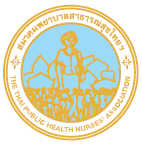Health Beliefs Model in Smoking Prevention and Attitudes Towards Smoking and Its Relationship with Self Efficacy of Smoking Control Among Lower Secondary School Students in Minburi District
Keywords:
Smoking control, Health beliefs, Self-efficacyAbstract
Teenagers also have higher smoking rates than the target of country so preventing smoking is imperative at the lower secondary school. This descriptive research aimed to examine the relationship between health belief in smoking prevention and attitude towards smoking and perceived self-efficacy in smoking control among secondary school students in Minburi District of four schools on 297 students in the year 2016. Instruments were questionnaire. Data were analyzed using statistics including percentage, mean, standard deviation, range and Pearson correlation was used to test the relationship between variables.
Results revealed that perceived health belief model in smoking prevention was significantly related to perceived self-efficacy in smoking control (p<.01, r=.249). Perceived attitude towards smoking was significantly related to perceived self-efficacy in smoking control (p<.05, r=-.104). It was found that each of health believes model perceived susceptibility to health-related problems due to smoking, perceived severity of smoking health hazard, perceived benefits of non-smoking, and perceived barriers to non-smoking were significantly related to perceived self-efficacy in smoking control (p<.01, r.=1.45, r=.144, r=.182, p<.05 r=.099 respectively). It is recommended that health belief model in the smoking prevention-based should be conducted in lower secondary school students anti-smoking campaign to promote explicit health beliefs model and attitude in smoking prevention and sustainable non-smoking control behavior should be done especially in the lower secondary school students.
References
Tobacco Consumption Control Bureau, Department of Disease Control, Ministry of Public [internet]. 2020 [cited 2020 December 31] Health Available from http://plan.ddc.moph.go.th/meeting30_1augsep/meetting30_1/Documents/7.pdf.
National Statistical Office. The smoking situation in Thailand [internet]. 2014 [cited 2017 July 5]. Available from: http://www.nso.go.th
Thipati S. ASTV Manager online 20 February 2015 [internet]. 2015 [cited 2016 April 5]. Available from: http://www.manager.co.th/QOL/ViewNews.aspx?News
Niyomrat V, Jard-ngoen G. The Effects of the Transtheoretical Model Process on Quit Smoking of High School Students in Bangklur District School. Princess of Narratives University Journal 2012; 4(2): 29-39.
Thanomsat K, Sunsern R. Factors Related to Early Smoking Stage Among Male Students at Lower Secondary Schools Under The Jurisdiction of Trat Education Service Area Office. Journal of Nursing and Education 2011; 4(3): 38-47.
Boonserm C, Sathitivanich P, Rivasanon W. Smoking Behaviors among Youth in Chiyaphum Province. Journal of Health Science 2009; 3(2): 6-14. (in Thai)
Kengganpanich T, Kengganpanich M, Temsirikunchai L. Factors Influencing on Young Women Smoking in Thailand. Journal of Health Education 2008; 31(10): 1-5. (in Thai)
Siriramee B, Siriramee T, Holumyong C, Champakao A, Kenroj P, Wongkaew T. The impact of local tobacco control policies in Thailand Smoking Group 5, .No.1. Nakhon Pathom: Institute for Population and Social Research Mahidol University; 2015.
Na Nakhon U. A Study The Relative Factors with Smoking Test of the Secondary School Students. Chonradsadornumrung School Muang District Chonburi Province; 2007. p. 8-10.
Rosenstock IM. Historical Origins of the Health Belief Model Health Education Monographs 1974; 2(4): 328-35.
Janz NK, Becker MH. The health belief model: A decade later. Health Education Quarterly 1984; 11: 1-47.
Bandura A. Self-efficacy: Toward a unifying theory of behavioral change. Psychological Review 1977; 84(2): 191-215.
Iamsupasit S. Theories and Techniques in Behavior Modification. Bangkok; Chulalongkorn university press; 2000. p.59.
Jankaew J, Homsin P, Srisuriyawet R. Factors Related to Smoking Initiation among Male Students in Lower Secondary Schools, Pathum Tani. Journal of Nursing Science Chulalongkorn University 2015; 27(2): 99-109. (in Thai)
Sudjaithami N. Attitudes and Intention of Ratchaphruek College’ s Students to Stop Smoking. Bangkok: Ratchaphruek College; 2012.
Ganley BJ, Rosario DI. The smoking attitudes, knowledge, intent, and behaviors of adolescents and young adults: implications for nursing practice. Journal of Nursing Education and Practice 2013; 3(1): 40-50. doi: https://doi.org/10.5430/jnep.v3n1p40.
Krejcie RV, Morgan DW. Determining Sample Size for Research Activities. Educational and Psychological Measurement 1970; 30(3): 607-10.
Sripitack S, Muangchang Y, Sanongyard J, Sirastidkul L, Yernyong S. The effectiveness of smoking preventive program among students in public school, Supanburi Province. Journal of Phrapokklao Nursing College 2012; 23(1): 38-52. (in Thai)
Sudjaithami N. Attitudes and Intention of Ratchaphruek College’ s Students to Stop Smoking. Bangkok: Ratchaphruek College; 2012.
Sirichai K. Applied statistics for behavioral research, Department of Research and Educational Psychology Chulalongkorn University, Thailand; 2012. p. 247-9.
Sutherland P. Cognitive Development Today Piaget and his Critics. Paul Chapman Publishing Limited; London; 1992. p. 16-28
Chandamee T. Alternative: The effectiveness of health education program by application the health belief model and social support for smoking prevention among Mathayomsuksa 3 students in extended opportunities education school, Muang district Nongkhai province. Udonthani Hospital Medical Journal 2008; 16(2): 729-36. (in Thai)
Kaewmanechai C. Smoke Behaviors of the Student Secondary School in Pho Tak Pithaya Pho Tak district, Nong Khai province. North-Eastern Primary Health Care Journal 2008; 22(3): 84-9. (in Thai)
Rongdej N, Plaimee S, Limpipattanawong B, Rongdej S, Luangdilok P. Smoking Behavior of Youth in Trang Provinceyouth in Trang Province. PrimaryPrimary Health Care Journal 2010; 24(3): 11-5. (in Thai)
Leurcha N, Nititham A. Preventive smoking behaviors among the male students of the Secondary School, Benjamarachanusorn. Master of Health education Thesis, Bangkok, Kasetsart University; 2007.
Mohammadpoorasl A, Fakhari A, Shamsipour M, Rostami F, Rashidian, H. Transitions between the stages of smoking in Iranian adolescents. Preventive medicine 2011; 52(2): 136-38.
Schermerhorn JR, Hunt JG, Osborn R. Organizational behaviour (7th ed). New York: John Wiley and Sons; 2000.
Downloads
Published
How to Cite
Issue
Section
License
บทความที่ตีพิมพ์และแผนภูมิรูปภาพถือเป็นลิขสิทธิ์ของวารสารพยาบาลสาธารณสุข (Thai Public Health Nurses Association)






